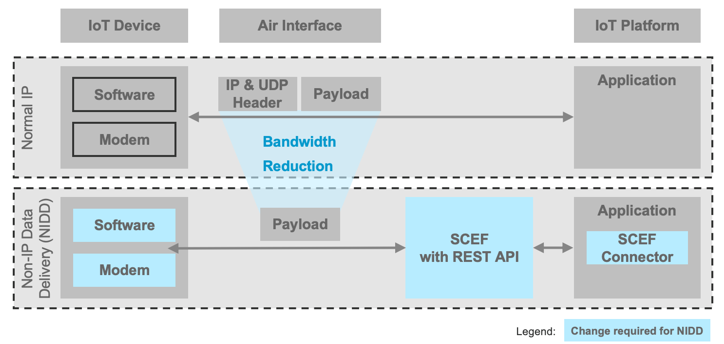Platform enabled ecosystem
SCEF & NIDD
Definition of SCEF and NIDD
NIDD (Non-IP Data Delivery) is a new LTE (4G) air interface that reduces bandwidth by stripping the IP headers (48-60 bytes with UDP) from the payload. It was introduced as part of the new NB-IoT (Narrow band IoT) to improve connectivity of IoT devices in mobile networks. Normal NB-IoT communication is IP-based.
Because NIDD IoT devices are not directly addressable through an IP address, two approaches are being discussed to communicate with IoT platforms [6]: A network element in the LTE network called PGW (Packet Data Network Gateway) assigns IP addresses to NIDD IoT devices and forwards NIDD data as UDP packets to IoT platforms, and vice versa. The other approach under discussion is introducing a new network element called SCEF:
SCEF (Service Capability Exposure Function) is an 3GPP standard designed to securely expose the services and capabilities provided by a mobile network. In particular the T8 reference point describes a REST API as an interface between the SCEF and external IoT applications. The API is defined using OpenAPI and defines how to access the NIDD payload. Additionally, it adds features like sending a trigger (e.g., URL) to devices, retrieving device monitoring data, reachability information and roaming data.

Technology evaluation
Typically, an IoT platform should only be allowed to access related IoT devices in the mobile network. The related security mechanism is not defined in the SCEF standard [2].
There does not seem to be SCEF-related software on GitHub and only one Stackoverflow question.
Market - current adoption
NIDD market support is starting for modems. NIDD usage in mobile networks is not commercially available. Some operators are performing proof-of-concepts for these technologies, for example, Deutsche Telekom (according to [5] using the PGW approach, not using SCEF) or MTS [7].
We are not aware of SCEF service available from operators in production.
Market - outlook
NIDD success is unclear because of
- ‘Chicken and egg’ ecosystem ramp-up: To be successful, all players in this market need to update their software, including IoT device vendors, modem vendors, and network operators. In case of SCEF usage, IoT platforms and IoT solutions providers also need to create SCEF connectors. It is unclear if all market players will see a positive business case to justify this investment.
- Challenging business case, since direct revenue for network operators decrease by reducing traffic.
- There are alternative IP-based ways to reduce the payload size (e.g. IETF ROHC) to only a few bytes per packets that come without the additional complexity introduced with NIDD.
Note that unlike NIDD, other mobile IoT protocols like LTE-M (CAT-M) and NB-IoT (CAT-NB) are IP-based and therefore do not require software changes on the device and application side.
While SCEF API has value beyond NIDD support, the success of operator introduced APIs was low in the past (business case, fragmented market, inconsistent coverage). See also Technology Radar entry 5G Positioning Services for similar challenges. In any case, a widespread adoption of the SCEF API would add value to IoT solutions using mobile communication as it exposes currently unavailable networking metrics to IoT platforms and solutions.
Further Information and Links
References
[1] 3GPP Specification 29.122: T8 reference point, specification of SCEF REST API, first version in Release 15.
[2] Definition Networks SCEF, detailed introduction by a vendor supplying a SCEF implementation.
[3] Understanding SCEF, brief introduction by Oracle from a telecommunication network viewpoint.
[4] Lightweight M2M 1.1: Managing Non-IP Devices in Cellular IoT Networks, introduction into NB-IoT and NIDD and an overview of how LWM2M could work over NIDD.
[5] NARROWBAND IoT, whitepaper from Deutsche Telekom.
[6] Appendix D. LwM2M over 3GPP CIoT - NB-IoT and LTE-M, explanation of the PGW vs. SCEF approach.
[7] MTS Launches NIDD and SCEF, in Russian, which refers to an IoT development kit with NIDD examples.
Notes
The 3GGP terms used in the IoT space differ from the terms used above: An IoT device is called UE (User Equipment), an IoT platform is represented as AS (application server) or SCS (services capability server), and the SCEF REST API is also referred to as T8 reference point.
